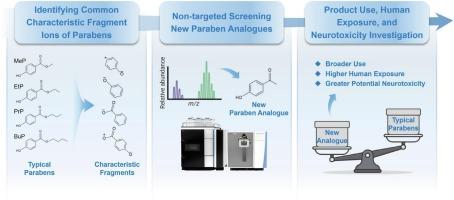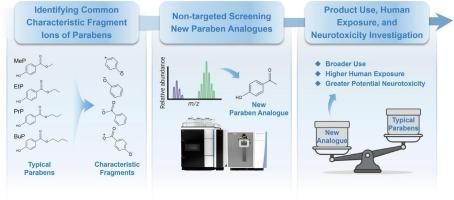From screening to risk assessment: a comparative study on product usage, human burden, and potential neurotoxicity of novel paraben analogues
IF 9.7
1区 环境科学与生态学
Q1 ENVIRONMENTAL SCIENCES
引用次数: 0
Abstract
Parabens are extensively used preservatives with endocrine disrupting effects and neurotoxicity. Their restricted usage may drive the development of alternatives for producing preservative-free products. Nevertheless, the prevalence and health risks of paraben analogues remain poorly understood. Herein, we screened potential paraben analogues using high-resolution mass spectrometry and assessed their prevalence in personal care products (PCPs) and population exposure trends. We first identified p-hydroxyacetophenone (PhAc), a structural analogue of parabens, in children’s urine based on the common fragmentation characteristics of parabens. Quantitative analysis revealed that the average content of PhAc in PCPs was 2–38 times higher than that of typical parabens. Furthermore, the longitudinal biomonitoring study conducted from 2016 to 2023 revealed that the geometric mean levels of PhAc in the urine of children aged 5–13 years in South China increase from 35.20 μg/L to 102.68 μg/L, which is 1–3 orders of magnitude greater than parabens. Nevertheless, PhAc is not a permitted preservative in PCPs and its health risk is unclear. To investigate the potential neurotoxicity of extensively present PhAc, neuronal cells were exposed to different concentrations of PhAc and typical parabens for 24 h, respectively. The results indicated that PhAc exhibited greater potential neurotoxicity than methylparaben, the most widely used paraben. Even exposure to doses comparable to urinary PhAc concentrations (100 nM-1 μM) could significantly disrupt metabolism homeostasis, damage cell membranes and morphology, and increase apoptosis rate in neuronal cells. Therefore, PhAc, a new paraben analogue with wider product applications, higher human exposure, and greater potential neurotoxicity, may pose considerable ecological and human health risks.


从筛选到风险评估:新型对羟基苯甲酸酯类似物的产品使用、人类负担和潜在神经毒性的比较研究
对羟基苯甲酸酯是一种广泛使用的防腐剂,具有内分泌干扰作用和神经毒性。它们的限制使用可能会推动生产无防腐剂产品的替代品的发展。然而,对羟基苯甲酸酯类似物的流行和健康风险仍然知之甚少。在此,我们使用高分辨率质谱法筛选潜在的对羟基苯甲酸酯类似物,并评估其在个人护理产品(pcp)中的流行程度和人群暴露趋势。基于对羟基苯甲酸酯的常见碎片特征,我们首先在儿童尿液中发现了对羟基苯乙酮(PhAc),这是对羟基苯甲酸酯的结构类似物。定量分析表明,pcp中PhAc的平均含量是典型对羟基苯甲酸酯的2 ~ 38倍。此外,2016 - 2023年的纵向生物监测研究显示,华南地区5-13岁 儿童尿液中PhAc的几何平均水平从35.20 μg/L上升到102.68 μg/L,比对羟基苯甲酸酯高出1-3个数量级。然而,PhAc不是pcp中允许的防腐剂,其健康风险尚不清楚。为了研究广泛存在的PhAc的潜在神经毒性,神经细胞分别暴露于不同浓度的PhAc和典型的对羟基苯甲酸酯24 h。结果表明,PhAc比应用最广泛的对羟基苯甲酸甲酯具有更大的潜在神经毒性。即使暴露于与尿中PhAc浓度相当的剂量(100 nM-1 μM),也会显著破坏代谢稳态,破坏细胞膜和形态,增加神经元细胞的凋亡率。因此,PhAc作为一种新的对羟基苯甲酸酯类似物,具有更广泛的产品应用、更高的人体暴露量和更大的潜在神经毒性,可能构成相当大的生态和人类健康风险。
本文章由计算机程序翻译,如有差异,请以英文原文为准。
求助全文
约1分钟内获得全文
求助全文
来源期刊

Environment International
环境科学-环境科学
CiteScore
21.90
自引率
3.40%
发文量
734
审稿时长
2.8 months
期刊介绍:
Environmental Health publishes manuscripts focusing on critical aspects of environmental and occupational medicine, including studies in toxicology and epidemiology, to illuminate the human health implications of exposure to environmental hazards. The journal adopts an open-access model and practices open peer review.
It caters to scientists and practitioners across all environmental science domains, directly or indirectly impacting human health and well-being. With a commitment to enhancing the prevention of environmentally-related health risks, Environmental Health serves as a public health journal for the community and scientists engaged in matters of public health significance concerning the environment.
 求助内容:
求助内容: 应助结果提醒方式:
应助结果提醒方式:


